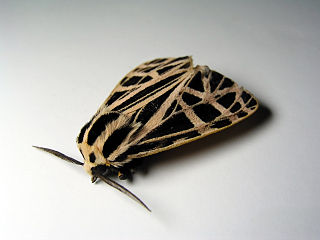
The parthenice tiger moth is a moth of the family Erebidae. It is found in south-eastern Canada, and the eastern United States. The moths are common in fields and woodland edges from June to late September. The moth is nocturnal and is attracted to light sources.

Apantesis virgo, the virgin tiger moth, is a moth of the family Erebidae. The species was first described by Carl Linnaeus in his 1758 10th edition of Systema Naturae. It is found in North America from Newfoundland south to Florida west to Alberta.
Apantesis behrii is a moth of the family Erebidae. It was described by Stretch in 1872. It is found from Oregon south to California. It is most common in the Siskiyou and Sierra Nevada ranges. The habitat consists of dry lithosol flood plains and balds in the mountains.
Apantesis blakei, or Blake's tiger moth, is a moth of the family Erebidae. It was described by Augustus Radcliffe Grote in 1864. It is found on the North American Great Plains, and southern prairie provinces of Canada.
Apantesis bolanderi is a moth of the family Erebidae. It was described by Stretch in 1872. It is only known from Mount Shasta in California.
Apantesis bowmani is a moth of the family Erebidae. It was described by Douglas C. Ferguson and B. Christian Schmidt in 2007. It is found in the United States in western Colorado and southeastern Utah. It occurs at elevations between 1,520 and 2,130 meters.
Apantesis complicata is a moth of the family Erebidae. It was described by Francis Walker in 1865. It is found on south-eastern Vancouver Island and several Gulf Islands of British Columbia and Washington. The habitat consists of dry Garry oak meadows and sandy beaches.
Apantesis eureka is a moth of the family Erebidae. It was described by Douglas C. Ferguson and B. Christian Schmidt in 2007. It has been found in the United States along the edges of the Great Basin in central Utah and in southwestern Idaho.
Apantesis elongata is a moth of the family Erebidae. It was described by Stretch in 1885. It is found in south-western British Columbia and west-central Alberta, south to Montana and Washington. It has also been recorded from north-eastern Oregon. The habitat consists of dry, montane, and subalpine meadows.

Apantesis figurata, the figured tiger moth, is a moth of the family Erebidae. It was described by Dru Drury in 1773. It is found in North America from southern Ontario and New Hampshire south to Georgia and west to Colorado and Texas.
Apantesis f-pallida is a moth of the family Erebidae. It was described by Strecker in 1878. It is found from south-eastern Utah and Colorado south to eastern Arizona, New Mexico and eastern Texas. It has also been recorded from west-central Nevada, and probably also occurs in Mexico.

Apantesis phyllira, the phyllira tiger moth, is a moth of the family Erebidae. It was described by Dru Drury in 1773. It is found in North America from Quebec and New England south to Florida and west to Texas, Colorado and Alberta. The habitat consists of dry, open woodland and grassland. The species is listed as endangered in Connecticut.
Apantesis placentia, the placentia tiger moth, is a moth of the family Erebidae. It was described by James Edward Smith in 1797. It is found in the south-eastern United States, from New Jersey to Florida. The habitat consists of dry, sandy open wooded areas, primarily pine barrens.
Apantesis speciosa is a moth of the family Erebidae. It was described by Heinrich Benno Möschler in 1864. It is found from Labrador west to British Columbia and Alaska. The habitat consists of wetlands, bogs and sub-Arctic tundra. The species is listed as endangered in Connecticut.
Apantesis ursina is a moth of the family Erebidae. It was described by Schmidt in 2009. It is found on the Channel Islands off the coast of southern California and in mainland south-western California from Kern County south to San Diego County. It is probably also present in Baja California.

Apantesis virguncula, the little virgin tiger moth, is a moth of the family Erebidae. It was described by W. Kirby in 1837. It is found across most of southern Canada and the United States, from the Rocky Mountains eastward. In the north, the range extends to northern Alberta and Newfoundland. In the south, it occurs along the Rocky Mountain to Apache County in Arizona and New Jersey in the east. It occurs in a variety of open wooded habitats, ranging from marshes, fens and bogs to transition parkland and prairie.
Apantesis williamsii, or Williams' tiger moth, is a moth of the family Erebidae. It was described by Charles R. Dodge in 1871. It is found in North America from the Northwest Territories east to the northern Great Lakes region, New Brunswick and New England. It also occurs throughout the northern Great Plains, south at higher elevations to Arizona and New Mexico, west to south-eastern British Columbia and eastern California.
Apantesis yavapai is a moth of the subfamily Arctiinae. It was described by Schmidt in 2009. It is only found in the San Francisco volcanic field in Coconino County, Arizona.
Apantesis yukona is a moth of the subfamily Arctiinae. It was described by Schmidt in 2009. It is found in Yukon. The habitat consists of dry, rocky or eroding south-facing slopes.
Apantesis arizoniensis is a moth of the family Erebidae. It was described by Robert Harper Stretch (1837–1926) in 1874. It is found from the southwestern United States to Colombia. In the United States, it has been recorded from California, east to western Texas and north to western Colorado and western Wyoming.





